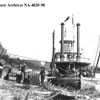Fort McMurray in the Era of Fur Trading

Fort McMurray lies in the Athabasca region, an area well known for its vast oil sand reserves. The oil sands were first extracted by local aboriginals who used the oil to caulk their canoes. In 1716, Henry Kelsey of the Hudson’s Bay Company explored Athabasca’s oil sands. It was the fur trade that first impacted the area’s economy however and not the oil sands. Peter Pond, of the North West Company, spearheaded White settlement in the Athabasca region. In the 1770s, he established the first settlement in the area known as “Pond’s House” on Elk River, to open trade with the Chipewyan and Cree in the area. “Fort of the Forks” was established by the North West Company at the present location of Fort McMurray.
The first permanent settlement at the Athabasca and Clearwater River junction was Fort McMurray, set up by Hudson’s Bay Company representative Henry “John” Moberly in 1870. Fort McMurray was named after Moberley’s friend and fellow employee. This fur trading post served as a transportation terminus whereby steamboats connected Fort McMurray with Edmonton along the Athabasca River. There were few permanent residents at the fort, mostly passing trappers, missionaries and explorers. Moberly soon discovered salt on the river banks, but transportation costs made a salt industry in the region unviable. Fort McMurray remained a small, remote northern outpost, closing down in 1898 because it was no longer profitable.

Fort McMurray continued to exist as a transportation terminus, maintaining a sparse population. By 1901, the population stood at 28 consisting of a handful of aboriginal and white trappers and fishers. Almost immediately, the Athabasca tar sands were starting to redefine Fort McMurray’s fate. Entrepreneurs and homesteaders began arriving between 1901 and 1906, driving up the population to 236. Once Alberta was incorporated as a province in 1905, oil sands speculation gained vigor as businessmen like John Cornwall and Count Alfred von Hammerstein started drilling for oil in the area. Between 1907 and 1912, Fort McMurray experienced its first significant boom period. Cornwall began subdividing the Clearwater flat lands to create a town site. Meanwhile, Von Hammerstein formed the Athabasca Oil and Asphalt Company. He then claimed to have found oil and began selling tracts of land in the area in 1910; he sold 11,404 acres of land to investors at a total cost of $21,913. In 1911, the population reached 1911 as new business entered the area. Fort McMurray had a school, a police detachment, a two-storey Roman Catholic Mission, and several churches but even after the boom, Fort McMurray remained a tiny settlement, continuing to serve as a gateway to the north, via its river system.
Interest in the oil sands did not end after the boom period. In 1913, the Federal Department of Mines began to send geologists to explore the oil deposits in the area and map the Athabasca oil sands. Sydney Ells, now considered the father of the oil sands, took on this task. He even pioneered early oil sands separation techniques, and looked at ways to use the tar sands in various capacities, such as laying bituminous pavement. Railway speculation followed the oil sands speculation, as rumours circulated about a coming railway line from Edmonton to Fort McMurray.

Despite all this speculation, during the First World War, Fort McMurray’s population plunged to 158 as many young men left to enlist in the home towns of their origins. At the end of the decade, Fort McMurray remained a small trapping, fishing, and river transportation hamlet. Moreover, it was soon to be overtaken by a new settlement directly south of it, because in 1921, the Alberta Great Waterways Railway passed over Fort McMurray and created the new boomtown Waterways, south of the fort.
References
Alberta Energy and Utilities Board. “Historical Overview of the Fort McMurray Area and Oil Sands Industry in Northeast Alberta.” Earth Sciences Report, 2000-05.
Alberta Government Publicity Bureau Department of Industry and Tourism. Survey of Fort McMurray. 1970.
Alberta Oil Sands Environmental Research Program. History of the Athabasca Oil Sands Region, 1890 to 1960s, Volume 1: Socio-Economic Development. Alberta Environment and Environment Canada: 1980.
Huberman, Irwin. The Place we call Home: A History of Fort McMurray as its People Remember. Historical Book Society of Fort McMurray: 2001.
Kerri, J. N. “ Fort McMurray: One of Canada’s Resource Frontier Towns.” (MA Thesis) University of Manitoba: 1970.
“Update ’83.” Fort McMurray Today, Wednesday June 29, 1983.



